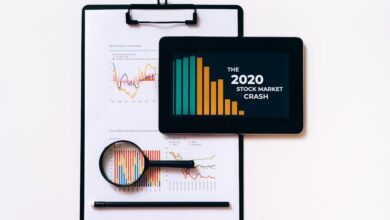Riding the Economic Roller Coaster: Insights on Recession Indicators, Investment Strategies, and Business Resilience

As the economic landscape undergoes fluctuations, the specter of a recession looms large, prompting businesses, investors, and consumers to brace for potential upheaval. Understanding the early warning signs of an economic downturn is crucial for effective preparedness, enabling stakeholders to navigate the challenges that arise during such periods. This article delves into the multifaceted impacts of recessions on various sectors, from consumer spending to global trade dynamics, while exploring how government stimulus can play a pivotal role in mitigating adverse effects. We will also examine strategic investment approaches tailored for recessionary environments and highlight the behavioral shifts that often accompany economic decline. By reflecting on lessons learned from past recessions, we aim to equip businesses and individuals with the knowledge needed to not only survive but also thrive in the face of economic adversity. Join us as we explore these critical topics, beginning with the essential indicators of an impending recession.
- 1. Recognizing the Signs: Early Indicators of an Economic Recession
- 2. Navigating the Storm: Investing Strategies for Recessionary Periods
- 3. Resilience in Crisis: How Businesses Can Prepare for Economic Downturns
1. Recognizing the Signs: Early Indicators of an Economic Recession
Recognizing the signs of an impending economic recession is crucial for individuals, businesses, and policymakers alike. Several early indicators can signal that an economy may be heading toward a downturn.
One prominent indicator is the yield curve, which represents the difference between short-term and long-term interest rates. When short-term rates rise above long-term rates, it often foreshadows a recession, as this inversion may suggest that investors expect slower economic growth in the future.
Another significant sign is a decline in consumer confidence. When consumers feel uncertain about their financial future, they tend to reduce spending, which can lead to decreased business revenues and ultimately slower economic growth. This sentiment is frequently measured through surveys that assess consumers' perceptions of the economy and their willingness to make large purchases.
Additionally, rising unemployment claims can be an early warning signal. An increase in claims suggests that businesses are beginning to lay off workers due to reduced demand for goods and services. This can create a cycle where reduced consumer spending leads to further layoffs, exacerbating the economic decline.
Manufacturing activity is also a critical indicator. A slowdown in manufacturing output, often tracked through indices such as the Purchasing Managers' Index (PMI), can indicate weakening demand and suggest that businesses are anticipating a downturn.
Finally, changes in corporate earnings reports can provide insights into economic health. A consistent trend of declining earnings across sectors may signal that companies are struggling, leading to further cost-cutting measures, including layoffs and reduced investment.
By monitoring these indicators, stakeholders can better prepare for potential economic challenges and take proactive measures to mitigate the impact of a recession.
2. Navigating the Storm: Investing Strategies for Recessionary Periods
Investing during recessionary periods requires a strategic approach to minimize risk and capitalize on potential opportunities. One of the primary strategies is to focus on defensive stocks, which tend to be more resilient during economic downturns. These include companies in sectors such as utilities, healthcare, and consumer staples, which provide essential goods and services that remain in demand regardless of economic conditions.
Additionally, investors may consider increasing their allocation to bonds, particularly government bonds, as they are generally viewed as safer investments during uncertain times. High-quality corporate bonds can also provide a stable income stream while offering lower risk than equities.
Diversification is another critical strategy. By spreading investments across various asset classes and industries, investors can reduce exposure to any single investment’s downturn. This may involve incorporating alternative assets, such as real estate investment trusts (REITs) or commodities, which can perform differently than traditional stocks and bonds.
Investors should also keep an eye on value investing during recessions. Economic downturns often lead to undervalued stocks, presenting opportunities to buy quality companies at discounted prices. Conducting thorough research to identify solid companies with strong fundamentals can yield significant returns when the economy rebounds.
Furthermore, maintaining a cash reserve can be beneficial. This liquidity allows investors to take advantage of market dips and purchase undervalued assets when prices are low.
Finally, it's crucial to remain patient and avoid panic selling. Historical data shows that markets tend to recover over time, and maintaining a long-term perspective can help investors navigate the volatility of recessionary periods more effectively. By employing these strategies, investors can not only protect their portfolios but also position themselves for future growth when the economic landscape improves.
3. Resilience in Crisis: How Businesses Can Prepare for Economic Downturns
In times of economic uncertainty, resilience becomes a critical attribute for businesses aiming to weather the storm of a recession. Preparing for downturns involves a multifaceted approach that encompasses financial planning, operational flexibility, and strategic foresight.
First and foremost, businesses should maintain a strong financial foundation. This includes building up cash reserves during prosperous times, reducing debt, and managing expenses prudently. Having a financial cushion allows companies to navigate periods of reduced revenue without resorting to drastic measures, such as layoffs or drastic cost-cutting that can harm long-term viability.
Operational flexibility is equally important. Businesses can enhance resilience by diversifying their supply chains and customer bases. Relying on a single supplier or a narrow market segment can expose a company to significant risks during economic downturns. By fostering relationships with multiple suppliers and exploring new markets, businesses can mitigate the impact of disruptions and maintain steady revenue streams.
Additionally, investing in technology and innovation can provide a competitive edge during challenging times. Companies that embrace digital transformation are often better positioned to adapt to shifting consumer behaviors and market conditions. For instance, e-commerce capabilities can help businesses reach customers who may be hesitant to shop in physical stores during a recession.
Lastly, cultivating a strong company culture that emphasizes adaptability and communication can empower employees to contribute to resilience efforts. Engaging staff in discussions about economic challenges and involving them in problem-solving can foster a sense of ownership and commitment, which is essential during tough times.
By proactively addressing financial stability, operational flexibility, technological advancement, and organizational culture, businesses can enhance their resilience and better navigate the uncertainties of economic downturns.
In conclusion, understanding the early warning signs of an economic recession is crucial for individuals, businesses, and policymakers alike. By recognizing these indicators, stakeholders can take proactive measures to mitigate potential impacts. As we have explored, recessions have far-reaching consequences across various sectors, influencing everything from consumer behavior to global trade dynamics.
Investing during these challenging times requires a strategic approach, emphasizing resilience and adaptability. The role of government stimulus cannot be overlooked, as it plays a vital part in cushioning the blow of economic downturns and fostering recovery. Additionally, the lessons learned from past recessions highlight the importance of preparedness, enabling businesses to navigate crises more effectively.
As economic landscapes continue to evolve, staying informed and developing robust strategies for both investment and operational resilience will be key. By embracing these insights and fostering a proactive mindset, individuals and businesses can not only survive but potentially thrive amidst the challenges of a recession.





